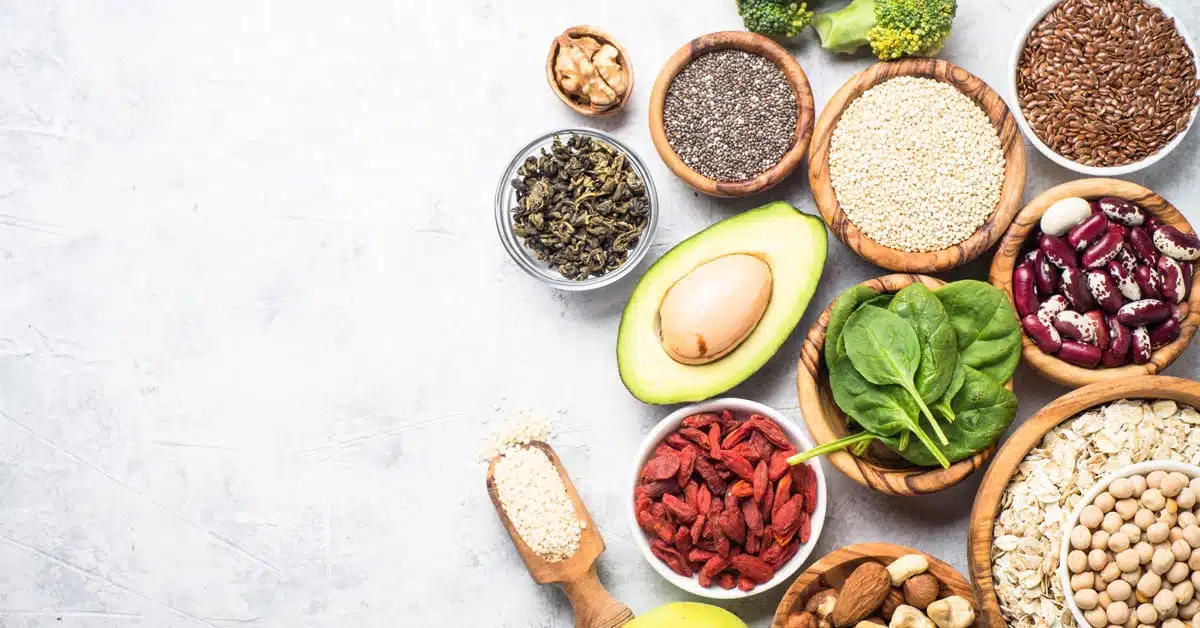Superfoods have become very fashionable in recent years, especially in the fitness scene. You've probably tried a quinoa recipe, mixed some chia seeds into your cereal, or incorporated avocados into your diet on a more or less regular basis. But did you know that superfoods are not super in every way?
No, it's not about the foods themselves, because they continue to be excellent due to a wide variety of factors. It's about the rampant superfood hype, which also has a dark side. So what is it about the dark side? And what is a possible solution to the problems that arise?
Light and shadow are close together
*Nutrient-rich foods such as chia seeds, avocados and quinoa are excellent foods and have been part of the basic diet in their respective countries of origin for thousands of years for good reason. The increased global demand for precisely these products also has many positive sides for the countries in which the superfoods are grown.
This is because the increasing demand and the resulting rise in sales prices also increases the income of local farmers, enabling them to provide their children with a better education and increase their prosperity. On the other hand, we as consumers benefit from the numerous health benefits of superfoods.
So it's a real win-win situation for everyone? Not necessarily, because at this point short-term thinking often leads to long-term damage in the areas of environment, economy and prosperity. We would like to highlight the problems caused by the hype, for example, using avocados, chia seeds and quinoa as examples.
Chia - A small seed conquers the world
Who would have thought that chia seeds were only permitted as an ingredient in baked goods within the European Union until 2013? Today, it's hard to imagine the fitness world without the little seeds. In addition to the chia seed hype wave from the USA, this is primarily due to the expansion of the approval for the sale of chia seeds and chia products in the EU.
However, the extremely high demand has not only brought the small seeds to the shelves of every discounter, no matter how small, but has also led to a significant increase in prices in the meantime, as the amount of chia seeds grown worldwide was far from being able to cover the quantity demanded. In the meantime, the price per kilogram climbed up to 10 euros.
It was only through the massive expansion of cultivation areas in South America and the start of cultivation in Australia and on the African continent that demand could be met. A perfect example, then, of the excellent functioning of the global market economy, because the increase in acreage also boosted the income of local farmers.
Extreme demand leads to problems
The increased demand has of course also led to every chia farmer wanting a piece of the pie. And preferably as quickly as possible and without regard to losses. Especially in South America, many small and large farms have increasingly focused on quantity rather than quantity. Especially through the massive use of sprays such as diquat and paraquat as well as mold toxins such as aflatoxins, yields were to be maximized as quickly as possible.
The result was in some cases inferior products that were also contaminated with significantly elevated pesticide levels. In addition, chia seeds were often unceremoniously planted on former soybean fields that were still contaminated by soybean cultivation. The result of this short-term thinking is therefore anything but a superfood.
Complete renunciation is also not a solution
The use of crop protection products definitely makes sense, because without them the world's population could not even be fed to begin with. However, common sense demands a rational use of these agents in order not to harm the end consumer, the soil and ultimately the health of the farmers. Doing without chia seeds completely is not a satisfactory solution.
Local farmers would lose their income, their children would lose their educational opportunities, and their countries would lose part of their growth in prosperity. Once again, the solution is conscious consumption. And here, once again, the age-old economic laws of supply and demand take effect. Because, if we as end consumers "demand" organic chia seeds, producers will adapt and push for sustainable cultivation. Then we have a real win-win situation for everyone.
Quinoa hype has positive and negative consequences for South America
The fact that quinoa enjoys such an excellent reputation among athletes is due in no small part to the fact that the pseudocereal has a very high protein content and also contains no gluten. Gradually, more and more fitness athletes began to incorporate quinoa into their diet.
This also brought the pseudocereal from South America into the focus of the Food and Agriculture Organization of the United Nations (FAO), which made 2013 the International Year of Quinoa. The confluence of these factors resulted in a huge increase in demand. At the same time, prices climbed rapidly, increasing more than tenfold at their peak.
The quinoa hype caused problems primarily in the traditional cultivation areas of the quinoa plant, in the highlands of the Andes. The soils found here, which are very rich in clay, offer the plant ideal growing conditions. Thanks to rising market prices, farmers here were also able to significantly increase their incomes, so that many families could now afford other foodstuffs. In return, however, quinoa consumption declined. In addition to the fact that the price of the foodstuff has risen significantly, this is also due to the fact that a large part of the harvest is reserved for export.
Overuse of cropland reduces food yields
Actually, the local farmers and their families benefit from the high demand for quinoa. However, in Peru and Bolivia in particular, the hype is leading to more and more areas being developed for the cultivation of quinoa. In addition to the clay soils at high altitudes, which are very well suited for cultivation, the less clayey and less nutritious soils are now also being used for cultivation in order to increase the production volume.
However, it is precisely the lack of nutrients that leads to a much lower yield increase than farmers would like. And so they open up further areas. As a result, many fields have to make way for other crops that grow much better. In addition, the nutrient-poor soils take much longer to regenerate. The bottom line is that the total possible food yield is reduced.
In addition, the continuous development of additional land leads to soil erosion, so that valuable cultivation areas are lost. Furthermore, quinoa farmers who grow quinoa outside the plant's natural home have to contend with crop losses due to pests that do not even exist in traditional growing areas.
The effects of the avocado craze
Hardly any superfood has experienced such a boom in recent years as the avocado. There is hardly a fitness cookbook in which at least a dozen recipes do not include the delicious green fruit on the list of ingredients. In the past three years alone, the global avocado harvest has been steady at more than 5 million tons, with most of the fruit exported to Europe and the United States. In Europe alone, around 550 million kilograms of the fruit will be consumed in 2018, according to the World Avocado Organization.
The avocado bill doesn't really add up
Traditionally, the avocado is grown in Mexico, where the fruit is processed, among other things, into the world-famous "guacamole" dip. The main beneficiary of the boom is the Mexican state of Michoacán, located in west-central Mexico. It's no wonder that local farmers are opening up more and more acreage for avocado cultivation and increasingly clearing forest areas in the process.
This is where the problems start, because it takes at least seven years for an avocado plant to bear harvestable fruit for the first time. This means that every new avocado plantation is an investment in the future. Once the avocado hype is over, the investment is for nothing. However, growing the fruit is currently worthwhile, because just 2,000 plants are enough to bring a farmer an annual profit of around one million U.S. dollars. Considering the average annual income in Mexico is 10,000 U.S. dollars, it is obvious why farmers are massively expanding the area under cultivation despite the risk.
The real problem, however, does not even lie in the personal risk of the individual farmer. After all, the farmer himself is responsible for which products he wants to plant and which not. The main problem is the avocado plant's enormous water consumption. To produce just one kilogram of avocados, the plant needs a good 1,000 liters of water. By way of comparison, one kilogram of potatoes, which also thrive excellently in the region, only requires around 130 liters of water.
One could therefore say that the country's soils are being used inefficiently, as these soils are being used for a resource-guzzling luxury product rather than for the much more important cultivation of basic foodstuffs. In Mexico, this has already led to numerous water shortages in the growing regions since the first avocado boom in the 1990s. In many places, the population even has to be supplied with drinking water by tankers, as the water in the rivers is diverted for the irrigation of the avocado plantations.
Replace Superfoods with Local Foods
Well, we don't want to spoil your avocado bread or quinoa salad. But still, it is necessary to take a look at the issue of superfoods. As with everything in life, moderate consumption is the happy medium that creates a win-win situation for as many parties as possible. It is also important to understand here that many of these superfoods are objectively nothing so special, but merely benefit from clever marketing and our desire for exoticism.
Soberly considered, for example, the chia seed for the South Americans is nothing different than a "boring" flax seed for us and quinoa is nothing different than the potato for us. In order to do something good for our body with "superfoods", we do not have to go far away. Even here in Europe, numerous plants grow that are at least as healthy.
The only drawback: We know these foods, and so they lack the magical aura of the exotic. So it makes perfect sense to use millet instead of quinoa, kale instead of pomegranate, and flaxseed instead of chia seeds. But it's still perfectly fine to use "superfoods" from overseas from time to time, as long as you don't see them as a panacea for your diet.




